The 1993 Bombay bombings was a series of 12 terrorist bombings that took place primarily in Hindu majority areas in Bombay, Maharashtra, on 12 March 1993. The single-day attacks resulted in 257 fatalities and 1,400 injuries. The attacks were coordinated by Dawood Ibrahim, leader of the Mumbai-based international organised crime syndicate D-Company. Ibrahim was believed to have ordered and helped organize the bombings through his subordinate Tiger Memon.
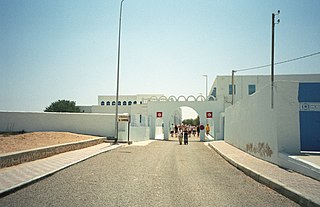
The Ghriba synagogue bombing was carried out by Niser bin Muhammad Nasr Nawar on the El Ghriba synagogue in Tunisia in 2002.
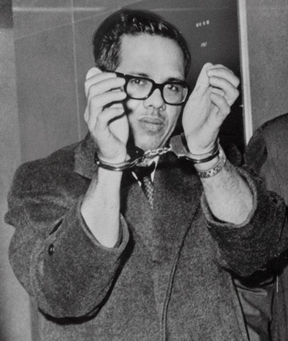
Orlando Bosch Ávila was a Cuban exile militant, who headed the Coordination of United Revolutionary Organizations (CORU), described by the United States Federal Bureau of Investigation as a terrorist organization. Born in Cuba, Bosch attended medical school at the University of Havana, where he befriended Fidel Castro. He worked as a doctor in Santa Clara Province in the 1950s, but moved to Miami in 1960 after he stopped supporting the Cuban Revolution.
Jeffrey "Free" Luers is an American political activist from Los Angeles, California, who served a ten-year prison sentence for an arson motivated by environmental concerns. On February 14, 2007, the Oregon Court of Appeals overturned Luers' sentence, instructing the Lane County circuit court to determine a new sentence. That court reduced the sentence from 22 years, 8 months to 10 years in February 2008, after what The Independent described as an "international campaign for a more appropriate sentence for a crime in which no one was hurt."
Justice Commandos of the Armenian Genocide (JCAG) was an Armenian militant organization active from 1975 to 1987.
David Rice and Edward Poindexter were African-American activists charged and convicted of the murder of Omaha Police Officer Larry Minard. Minard died when a suitcase bomb containing dynamite exploded in a North Omaha home on August 17, 1970. Officer John Tess was also injured in the explosion. Poindexter and Rice had been members of the Black Panther Party.

The Italicus Express massacre was a terrorist bombing in Italy on a train of the public rail network. On 4 August 1974, the bomb attack killed 12 people and wounded 48. Responsibility was claimed by the neo-fascist terrorist organization Ordine Nero.
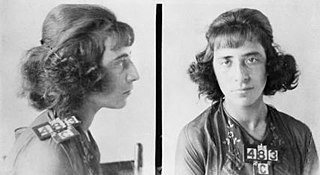
Florence Lassandro was an Italian-Canadian bootlegger who was the only woman to be hanged in Alberta.

The FBI's Ten Most Wanted Fugitives during the 1970s is a list, maintained for a third decade, of the Ten Most Wanted Fugitives of the United States Federal Bureau of Investigation.

The Harvey's Resort Hotel bombing took place on August 26–27, 1980, when several men masquerading as photocopier deliverers planted an elaborately booby trapped bomb containing 1,200 pounds (540 kg) of dynamite at Harvey's Resort Hotel in Stateline, Nevada, United States. During an attempt to disarm the bomb, it exploded, causing extensive damage to the hotel but no injuries or deaths. The total cost of the damage was estimated to be around $18 million. John Birges Sr. was convicted of having made the bomb with a goal of extorting money from the casino after having lost $750,000 there. He died in prison in 1996 at age 74.
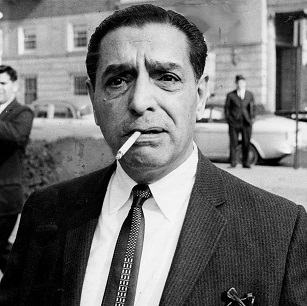
The Patriarca crime family, also known as the New England Mafia, the Boston Mafia, the Providence Mafia or the Office, is an Italian-American Mafia crime family operating in New England. The family consists of two distinct factions, one based in Providence, Rhode Island, and the other in Boston, Massachusetts. The Patriarca family is primarily active in Massachusetts, Rhode Island and Connecticut, with other territory throughout New England.
Revolutionary Struggle is a Greek anarchist, anti-imperialist, urban guerrilla group known for its attacks on Greek government buildings and the American embassy in Athens. It is designated as a terrorist group by the Greek government, the European Union (EU), and the United States.
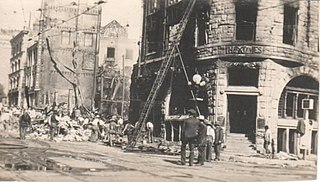
The Los Angeles Times bombing was the purposeful dynamiting of the Los Angeles Times Building in Los Angeles, California, United States, on October 1, 1910, by a union member belonging to the International Association of Bridge and Structural Iron Workers (IW). The explosion started a fire which killed 21 occupants and injured 100 more. It was termed the "crime of the century" by the Los Angeles Times newspaper, which occupied the building.

In the United States, a common definition of terrorism is the systematic or threatened use of violence in order to create a general climate of fear to intimidate a population or government and thereby effect political, religious, or ideological change. This article serves as a list and a compilation of acts of terrorism, attempts to commit acts of terrorism, and other such items which pertain to terrorist activities which are engaged in by non-state actors or spies who are acting in the interests of state actors or persons who are acting without the approval of foreign governments within the domestic borders of the United States.

The 1915 Vanceboro international bridge bombing was an attempt to destroy the Saint Croix–Vanceboro Railway Bridge on February 2, 1915, by Imperial German spies.
Alan Berkman was an American physician and activist in the Students for a Democratic Society and Weather Underground who went to prison for his involvement in a number of robberies staged by the organizations and their offshoots. Released after eight years in prison for armed robbery and explosives possession, Berkman provided medical care to the homeless and founded Health GAP to help provide AIDS pharmaceuticals to some of the world's poorest nations.

Carlos Alberto Torres is a militant Puerto Rican nationalist. He was convicted and sentenced to 78 years in a U.S. federal prison for seditious conspiracy, conspiring to use force against the lawful authority of the United States. He served 30 years and was released on parole on July 26, 2010.
William Morales is a Puerto Rican member of the Fuerzas Armadas de Liberación Nacional Puertorriqueña (FALN). He was convicted in February 1979 for possession of explosives, and possession and transportation of explosives and a shotgun. He escaped from Bellevue Hospital in May 1979 and subsequently fled to Mexico, where he was held by the authorities, before emigrating to Cuba in 1988. Morales is currently on the FBI Most Wanted Terrorists list with a reward of $100,000 for information leading to his arrest.












